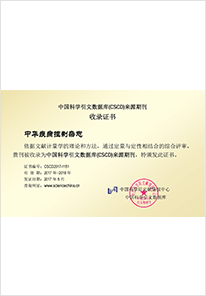2021 Vol. 25, No. 4
Display Method:
2021, 25(4): 373-375.
doi: 10.16462/j.cnki.zhjbkz.2021.04.001
Abstract:
2021, 25(4): 376-383.
doi: 10.16462/j.cnki.zhjbkz.2021.04.002
Abstract:
2021, 25(4): 384-388.
doi: 10.16462/j.cnki.zhjbkz.2021.04.003
Abstract:
2021, 25(4): 389-394.
doi: 10.16462/j.cnki.zhjbkz.2021.04.004
Abstract:
2021, 25(4): 400-404.
doi: 10.16462/j.cnki.zhjbkz.2021.04.006
Abstract:
2021, 25(4): 405-410.
doi: 10.16462/j.cnki.zhjbkz.2021.04.007
Abstract:
2021, 25(4): 411-415.
doi: 10.16462/j.cnki.zhjbkz.2021.04.008
Abstract:
2021, 25(4): 416-420.
doi: 10.16462/j.cnki.zhjbkz.2021.04.009
Abstract:
2021, 25(4): 421-426.
doi: 10.16462/j.cnki.zhjbkz.2021.04.010
Abstract:
2021, 25(4): 427-431.
doi: 10.16462/j.cnki.zhjbkz.2021.04.011
Abstract:
2021, 25(4): 432-438.
doi: 10.16462/j.cnki.zhjbkz.2021.04.012
Abstract:
2021, 25(4): 439-444.
doi: 10.16462/j.cnki.zhjbkz.2021.04.013
Abstract:
2021, 25(4): 445-453.
doi: 10.16462/j.cnki.zhjbkz.2021.04.014
Abstract:
2021, 25(4): 454-459.
doi: 10.16462/j.cnki.zhjbkz.2021.04.015
Abstract:
2021, 25(4): 460-465.
doi: 10.16462/j.cnki.zhjbkz.2021.04.016
Abstract:
2021, 25(4): 466-471.
doi: 10.16462/j.cnki.zhjbkz.2021.04.017
Abstract:
2021, 25(4): 472-477.
doi: 10.16462/j.cnki.zhjbkz.2021.04.018
Abstract:
2021, 25(4): 478-482.
doi: 10.16462/j.cnki.zhjbkz.2021.04.019
Abstract:
2021, 25(4): 483-487.
doi: 10.16462/j.cnki.zhjbkz.2021.04.020
Abstract:
2021, 25(4): 488-491.
doi: 10.16462/j.cnki.zhjbkz.2021.04.021
Abstract:
2021, 25(4): 492-496.
doi: 10.16462/j.cnki.zhjbkz.2021.04.022
Abstract:


 Email alert
Email alert RSS
RSS Abstract
Abstract HTML
HTML PDF
PDF





